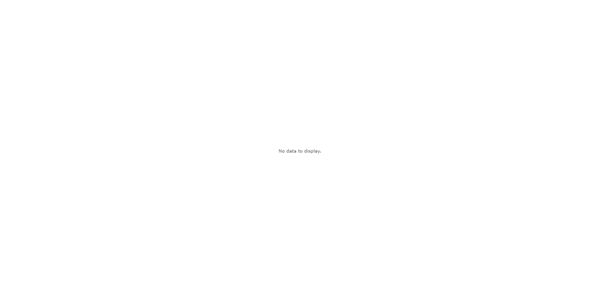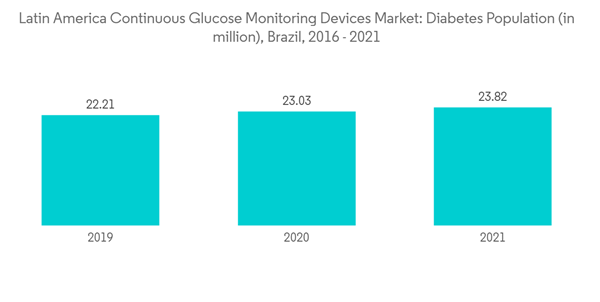The COVID-19 pandemic has put populations, governments, and healthcare systems around the world to the test. Brazil reported the first suspected and confirmed cases in Latin America on January 27th and February 26th, respectively. Most Latin American countries failed to implement timely diabetes protection measures, which may have serious consequences for individuals, health systems, and economies.
Diabetic prevalence is high in Latin American countries, and Mexico is known to have a high number of diabetic patients due to the country's growing prevalence of Type-2 diabetes. Over the last 40 years, the steadily increasing obesity rate, combined with a genetic predisposition to Type-2 diabetes, has been a major driver of the increase in the Type-2 diabetic population. Diabetes affects nearly 10% of the total population today. Type-2 diabetes is the most common type of diabetes in the Latin American region, accounting for nearly 90% of the total diabetic population in 2021. According to Universal Health Coverage 2022, Argentina, Brazil, Colombia, and Mexico achieved an overall index of essential coverage of 76-77 percent, with households spending less than 25% of their income on health care. Access to primary healthcare systems and coverage for noncommunicable diseases improved service coverage, while an increase in the number of qualified healthcare personnel allowed for community outreach.
The rate of newly diagnosed Type 1 and Type 2 diabetes cases is seen to increase, mainly due to obesity, unhealthy diet, and physical inactivity. The rapidly increasing incidence and prevalence of diabetic patients and healthcare expenditure in developed countries are indications of the increasing usage of diabetic care products. Moreover, the increasing adoption of insulin delivery devices and the rising prevalence of diabetes are driving market growth. Leading manufacturers are focusing on technological innovations and the development of advanced products to gain a substantial share of the market. Continuous Glucose Monitoring is a new glucose monitoring device that tracks blood glucose levels throughout the day and night. Sensors are disposable devices that measure blood glucose levels and are placed under the skin. A sensor can last several days before needing to be replaced. Transmitters and receivers are examples of durables. The sensor is connected to transmitters, and a reader (receiver) receives and displays the measurements. The device takes measurements in real-time.
South America Continuous Glucose Monitoring Market Trends
The Sensors Segment is Having the Highest Market Share in Latin America Continuous Glucose Monitoring Market.
Continuous glucose monitoring sensors detect blood sugar levels using glucose oxidase. Glucose oxidase converts glucose to hydrogen peroxidase, which reacts with the platinum inside the sensor to generate an electrical signal that is sent to the transmitter. The most important component of continuous glucose monitoring devices is the sensor. During the forecast period, technological advancements to improve sensor accuracy are expected to drive segment growth. For the convenience of diabetic patients, continuous glucose monitoring has become a popular alternative to portable finger-prick glucometers on the market. Furthermore, current continuous glucose monitoring devices can either display trends in blood glucose levels by downloading data or provide a real-time picture of glucose levels via receiver displays. Diabetes already has a disproportionate impact on Mexican Americans. The use of CGM in mostly Mexican American adults provides important information about blood sugar profiles for people at risk of or living with T2D. These findings could pave the way for new approaches to lowering the risk of developing T2D and better understanding the progression of diabetes in this population. Continuous glucose monitoring (CGM) has numerous advantages for diabetics. However, the majority of CGM research has been conducted on White participants with type 1 diabetes. As a result, we have limited knowledge and experience with CGM in racial/ethnic minority populations with type 2 diabetes (T2D) who do not use insulin.Thus, owing to the above-mentioned factors the segment is expected to grow over the forecast period.
Brazil is Expected to Dominate the Latin America Continuous Glucose Monitoring Devices Market.
The Brazilian health system is managed by each state and local health secretariat and is governed by the MOH. Furthermore, in many towns where the public sector is unable to meet people's needs, partnerships with private organizations to increase access to PHC have been established. The Brazilian health system covers medicines through several programs, including a 20% increase in access to essential medicines. Brazil has an extensive free immunization program. Over the last 20 years, Brazil has faced numerous lawsuits demanding coverage of high-cost drugs used to treat diabetes and other rare or low-prevalence diseases. The diabetic population in Brazil is expected to grow by 74% between 2017 and 2045. Brazil is currently the world's sixth most populous country, with the fourth highest prevalence of diabetes. The Brazilian government is encouraging diabetes patients to take the medication to reduce the country's death rate. The Brazilian Ministry of Health collaborated with private pharmacies in Brazil to provide diabetes patients with two types of insulin (regular human insulin and isophane insulin or NPH) and three oral antidiabetic medications (5 mg glibenclamide and 500 and 850 mg metformin) for free.Therefore, owing to the aforesaid factors the growth of the studied market is anticipated in the Latin America Region.
South America Continuous Glucose Monitoring Industry Overview
A significant share of the Latin America Continuous Glucose Monitoring Devices market study is held by CGM manufacturers that are concurrent with strategy-based M&A operations, and these manufacturers are continuously entering new markets to generate new revenue streams and boost existing ones. The market studied is consolidated with Dexcom, Abbott, and Medtronic, holding a high market share, followed by regional manufacturers accounting for a relatively smaller share.Additional Benefits:
- The market estimate (ME) sheet in Excel format
- 3 months of analyst support
This product will be delivered within 2 business days.
Table of Contents
Companies Mentioned (Partial List)
A selection of companies mentioned in this report includes, but is not limited to:
- Abbott Laboratories
- DexCom, Inc.
- Medtronic Plc
- Eversense
Methodology

LOADING...










